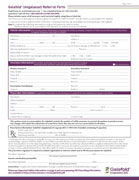For adults with confirmed Fabry disease and an amenable GLA variant
Galafold—the first oral precision medicine for Fabry disease
Galafold is a small-molecule alpha-Gal A pharmacological chaperone that reversibly binds to the active site of alpha-Gal A and stabilizes the protein.1,2
Galafold restores the normal pathway for trafficking amenable alpha-Gal A to the lysosome.2
Galafold has a large apparent volume of distribution of approximately 89 L (range: 77 to 133 L) at steady state,2 suggesting it is well distributed into tissues.1,3
Galafold reduced disease substrate (GL-3) in kidney interstitial capillaries (KIC) over 6 months.2*
The most common adverse drug reactions reported with Galafold (≥10%) are headache, nasopharyngitis, urinary tract infection, nausea, and pyrexia.2
was treated
with migalastat in a clinical trial4
are being treated
with Galafold4†
for patients
on Galafold4‡
Please see Important Safety Information for Galafold below.
Galafold: a distinct approach to the treatment of Fabry disease
- Pharmacological chaperones are small-molecule analogs of the protein’s substrate with the ability to bind and stabilize certain variant forms of the proteins so that they can be trafficked from the endoplasmic reticulum (ER) into the lysosome, restoring intralysosomal activity2,5-7
- Galafold binds and stabilizes alpha-Gal A in patients with an amenable GLA variant2
- Alpha-Gal A from an amenable GLA variant is trafficked from the ER through the Golgi apparatus to the lysosomes2
See how Galafold works
Identify whether your patient's GLA variant is amenable to treatment with Galafold
Starting with your patient's GLA genotype, you can determine whether the GLA variant is amenable in 1 of 3 ways:
The Galafold Full Prescribing Information includes a list of GLA variants that have been identified as amenable to Galafold.
Check amenability on this website to determine whether a specific GLA variant has been listed as amenable in the Full Prescribing Information.
For answers to questions about amenability, you can also contact Amicus Medical Information at 1-877-4-AMICUS or MedInfoUSA@amicusrx.com.
Start a patient
